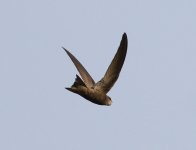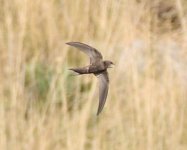Thank you, Mike and Stew, for your input for our Mallorca Big Day on 13. July 2019!
Here is the brief report of this crazy but really fantastic day. We started at 5:27 am at our finca (south-east of Pollenca) with a calling Stone Curlew and ended at Cape Formentor with Scopoli's Shearwaters over the ocean and Eleonora's Falcons in the sky at sunset.
The total number of bird species observed by my brother Fabian and me was 78 (+1 provisional, see below). Although we missed a few target species we hoped to see, we found others we didn't expect!
Here is a list of all birds observed with the respective locations:
Our finca (south-east of Pollenca), 5:27 am:
1) Stone Curlew (heard only, but later also seen at s'Albufera)
s'Albufera (main locations around the visitor center), ~6:10-9:45 am:
2) Common Blackbird
3) Cetti's Warbler
4) Common Wood Pigeon
5) House Sparrow
6) Zitting Cisticola
7) European Bee-eater
8) Purple Heron
9) Cattle Egret
10) Mallard
11) Black-crowned Night Heron
12) Little Egret
13) Glossy Ibis
14) Eurasian Coot
15) Purple Swamphen
16) Common Moorhen
17) European Greenfinch
18) Mediterranean Gull
19) Sardinian Warbler
20) Black-winged Stilt
21) Little Ringed Plover
22) Black-headed Gull
23) Common Shelduck
24) Western Marsh-Harrier
25) Marbled Duck
26) Common Tern
27) Eurasian Hoopoe
28) Spotted Flycatcher
29) Common Swift
30) Common Snipe
31) European Serin
32) European Goldfinch
33) Great Reed Warbler
34) Red-knobbed Coot
35) Moustached Warbler
36) Blackcap
37) Little Bittern
38) European Reed Warbler
39) Great Crested Grebe
40) Squacco Heron
41) Great Tit
42) Gadwall
43) Kentish Plover
44) Grey Heron
45) Green-winged Teal
46) Yellow Wagtail
47) Yellow-legged Gull
48) Common Stonechat
Salinas d'Albufera (stationary), ~9:55-10:05 am:
49) Water Rail
Road to Son Bosc/Depuradora, ~10:20-10:30 am:
50) Common Kestrel
51) Eurasian Collared Dove
52) Rock Pigeon (Feral)
Depuradora de S'Illot (raised platform), ~10:45-11:15 am:
53) Little Grebe
54) Red Kite
54) Green Sandpiper
55) Ruddy Shelduck
Albufereta (coast and first observation platform), ~12:00-12:25 am:
56) Audouin's Gull
57) Osprey
Pollenca backlanes (drive through backlanes with few stops), ~12:45-1:15 pm:
58) Woodchat Shrike
Port de Pollenca (breakwaters at beach), ~1:40-2:00 pm:
59) European Shag
Cuber Reservoir (south shore between parking lot and just past the dam), ~3:20-5:20 pm:
60) Common (Red) Crossbill
61) Black Vulture
62) Common Chaffinch
63) Griffon Vulture
64) Firecrest
65) Blue Tit
66) Common Nightingale
67) Common Linnet
68) Common House Martin
69) Booted Eagle
70) Tawny Pipit
71) Cirl Bunting
Gorg Blau Reservoir (stationary), ~5:50-6 pm:
72) Common Raven
Cape Formentor (stationary at Mirador Es Colomer), ~7:10-7:25 pm:
73) Eurasian Crag Martin
74) Scopoli's Shearwater
* Provisional: Pallid Swift (see photos)
Cape Formentor (lighthouse), ~7:10-7:25 pm:
75) Blue Rock Thrush
76) Peregrine Falcon
77) Eleonora's Falcon
We also tried for Scops Owl and European Nightjar after dark but could not find/hear any in the area of La Font between Pollenca and Port de Pollenca. My brother had both there 2 years ago every night.
We are not very familiar with Pallid Swift identification and the more you read about it the more tricky it seems to get. However, we were quite confident that we saw some at Cape Formentor.
I tried to take pictures of the candidates (see attached) and we are curious about your opinions and hope that we can add the 78th species to our list.
Is there any previous data on Big Days on Mallorca in general and in July in particular?
Anyhow, it was an exhausting but really great day!
Cheers,
Stefan and Fabian







